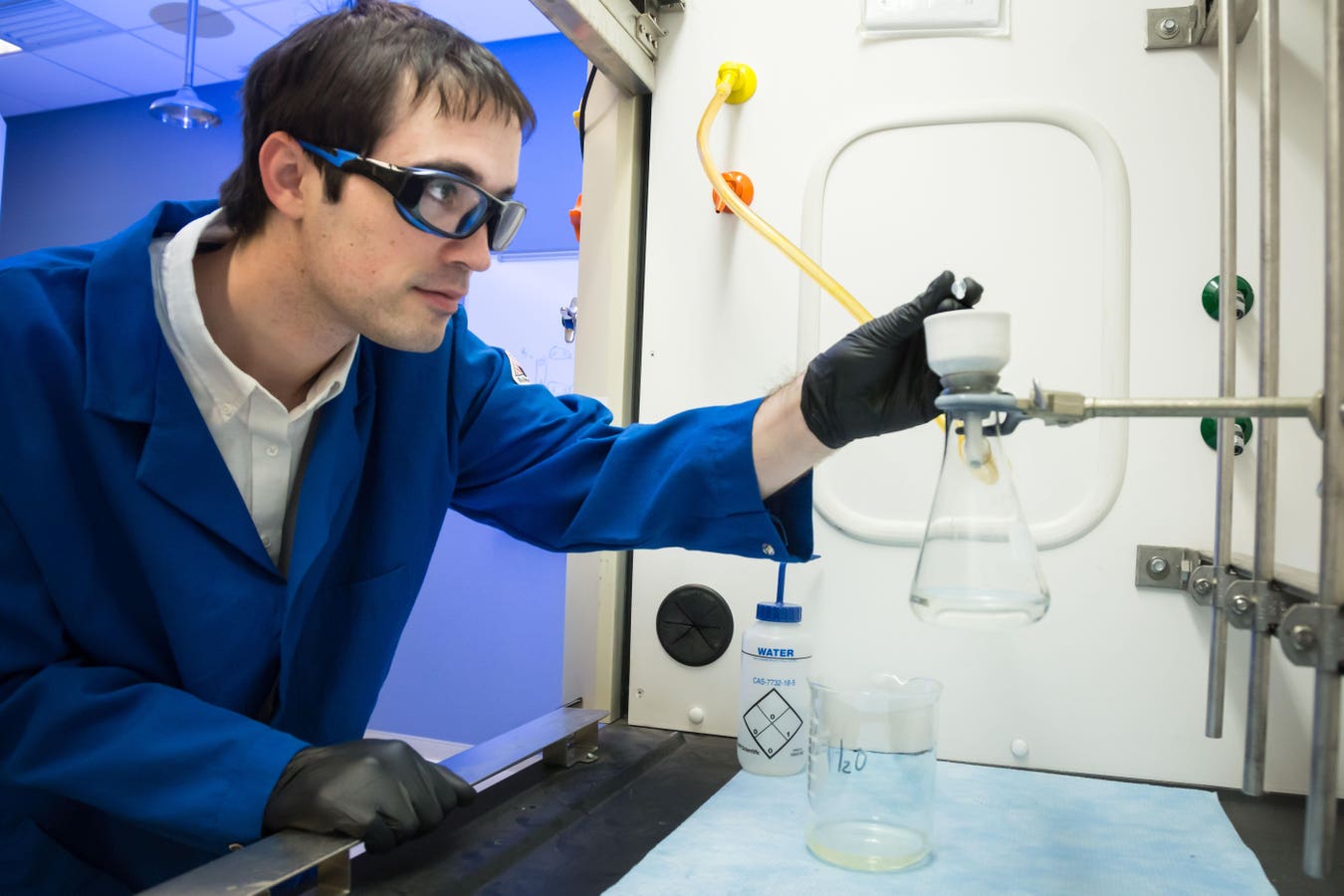Oak Ridge National Laboratory scientist Charles Seipp is one of many working to find the chemical … [+]
Carbon capture can be relied upon to consistently do one thing: ignite passionate arguments.
On one side are those who say that every dollar spent on this climate technology is a waste. In this view, carbon capture is a smoke screen the efforts of oil companies to maintain their profitable franchises at the expense of the health of the planet.
On the other hand are those who think that between point source capture (capturing concentrated emissions from a smokestack) and direct air capture (capturing highly diluted emissions directly from the atmosphere), humans can completely reverse the progress of global warming and live happily ever after. after.
Both sides are wrong.
For those on the anti-grab side, it’s time to wake up. A phenomenal amount of carbon is embedded in everything the citizens of developed countries touch. Quitting hydrocarbons cold turkey would set civilization back hundreds of years.
For those on the capture side, try counting how many point source capture systems and DAC plants you would need to reduce atmospheric carbon to pre-Industrial levels. Who will pay for this? How much will it cost to bring back extinct species and cool the oceans?
A huge amount of investment money is pouring into carbon capture technology right now, and the approaches can be confusing.
This article provides an investor-level overview of the three technologies used for point source capture, and the following provides the strengths and weaknesses of each from an investor’s perspective. I will delve into direct air capture in a follow up.
How does carbon capture work?
Carbon dioxide in combustion exhaust is difficult to capture because it is dilute. There are two general approaches to carbon capture—increasing CO concentration2 in downloading and finding a chemical composition that captures even dilute concentrations effectively.
The easiest way to increase CO concentration2 in a discharge current is changing the input fuel. Burning coal generates about twice as much carbon dioxide as burning natural gas. Burning biomass releases less CO2 than coal but more than natural gas.
A more difficult way to increase CO2 the focus is on changing the equipment and processes used to burn the fuel.
Oxycombustion, the approach that gives the highest CO22 exhaust concentration, burns organic fuels using pure oxygen instead of ambient air, producing an exhaust about two-thirds CO2 and one-third water vapor, plus some impurities, depending on the type of fuel being burned. CO capture2 using an oxy-combustion system is easy – filter out the impurities, dehydrate the exhaust stream and be left with almost pure CO2.
Oxygen combustion – the burning of fuel in pure oxygen – creates an exhaust stream that has a high concentration of … [+]
Pre-combustion capture, another technology that increases CO2 concentration, involves two steps: first, the hydrocarbon fuel is split to produce “singa” (carbon monoxide + hydrogen gas). Second, the target gas is exploded with steam, converting the carbon monoxide to carbon dioxide and creating a higher concentration of hydrogen gas. These coupled processes create two discharge streams: one rich in CO2 and another rich in hydrogen.
Pre-combustion treatment of coal generates clean-burning hydrogen and a highly concentrated stream … [+]
Carbon dioxide in a pre-combustion system has a concentration between 15% and 60%, depending on the starting hydrocarbon used, and can be easily captured by dissolving CO2-Charged air in a tank containing organic compounds. The hydrogen-rich stream is burned to produce nearly zero-carbon heat or power (burning hydrogen is zero-carbon, but only about 85% to 90% of the syngas is converted in the “steam reforming” process). The National Energy Technology Laboratory has a good video explaining pre-combustion gasification technology.
Final capture technology is the most widely used in modern industry and, unlike oxy-combustion and pre-combustion, it aims to capture low-concentration CO2. These systems use one or more compounds that readily chemically bind to carbon dioxide molecules or block them mechanically (ie, without forming chemical bonds).
A class of chemicals called amines are often used to chemically bond with CO2. Amines bond with CO2 at low temperatures and release when heated. Specific salts or a class of chemicals called zeolites can trap CO2 mechanically.
Post-combustion carbon capture is the solution that receives the most technical and investment attention … [+]
This process is called “post-combustion capture” and CO concentration2 in the hot exhaust stream is anywhere from ~2% to ~15%, depending on the fuel burned to create the exhaust. About a year ago, I wrote about an innovative carbon capture firm called Carbon Clean that has developed a particularly effective carbon capture chemical blend.
The planet needs carbon capture
Unless everyone reading this article wants to learn how to make their own soap and spin their own cloth, our civilization must continue to burn carbon-based fuels. However, not only do we need to stop releasing carbon dioxide into the atmosphere, we also need to reduce the amount of carbon dioxide already there.
Changing the way we practice agriculture—using regenerative methods and local food chains—is the first initiative we need to pursue. Changing agriculture is necessary and may be enough to solve our climate crisis, but I doubt we can change attitudes, business models and supply chains fast enough.
Carbon capture, part of what Energy Secretary Jennifer Granholm calls a “silver lining strategy,” is the second initiative we must pursue…yesterday. Pushing this technology is also necessary, but not sufficient.
My next article will examine the strengths and weaknesses of each of the three technological pathways to carbon capture and explain why carbon capture is so difficult.
Smart investors take note.
